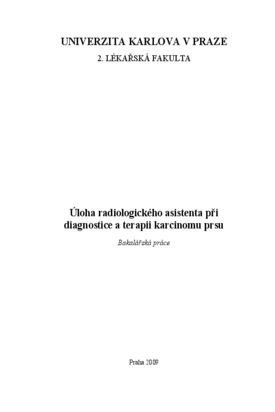Úloha radiologického asistenta při diagnostice a terapii karcinomu prsu
The role of radiologist assistant in the diagnostics and therapy ofbreast cancer
bakalářská práce (OBHÁJENO)

Zobrazit/
Trvalý odkaz
http://hdl.handle.net/20.500.11956/20623Identifikátory
SIS: 71569
Katalog UK: 990011098680106986
Kolekce
- Kvalifikační práce [1802]
Autor
Vedoucí práce
Oponent práce
Malinová, Běla
Fakulta / součást
2. lékařská fakulta
Obor
Radiologický asistent
Katedra / ústav / klinika
Klinika zobrazovacích metod
Datum obhajoby
24. 4. 2009
Nakladatel
Univerzita Karlova, 2. lékařská fakultaJazyk
Čeština
Známka
Velmi dobře
Bakalářská práce "Úloha radiologického asistenta při diagnostice a terapii karcinomu prsu". Skládá z pěti hlavních částí a několika podčástí. První část se věnuje popisu anatomie ženského prsu. Druhá část je věnována rozdělení nádorů prsu a zahrnuje i rizikové faktory pro vznik karcinomu prsu. Následující část se zaměřuje na diagnostiku karcinomu prsu. Diagnostika zahrnuje mamografii, ultrazvuk prsu, duktografii, mamografickou stereotaxi, magnetickou rezonanci prsu, CT prsu a mamoscintigrafii. Radiologický asistent se nejvíce podílí na mamografickém vyšetření. Čtvrtá část se věnuje léčbě maligních nádorů, hlavně karcinomu. Patří sem chirurgická léčba, radioterapie, chemoterapie a brachyterapie. Největší důraz je dáván na radioterapii, chemoterapii a brachyterapii, kde se radiologický asistent uplatňuje. Poslední část práce je věnována prevenci karcinomu prsu. Prevence zahrnuje klinické vyšetření, samovyšetření a mamografický screening. Dále je práce doplněna obrázky a seznamem použitých materiálů. Powered by TCPDF (www.tcpdf.org)
Bachelor thesis "The role of radiological assistant in the diagnosis and treatment of breast cancer". The work is composed of five main parts and several subparts. The first part deals with the description of anatomy of female breast. The second part is devoted to the classification of breast tumors and includes risk factors for the emergence of breast cancer. The following section is devoted to the diagnosis of breast cancer. Diagnosis includes mammography, breast ultrasound, duktography, mammography stereotax, breast magnetic resonance, CT and breast mammoscintigraphy. The most important for radiological assistant is mammography. The fourth part is about the treatment of malignant tumors especially carcinoma. These include surgical treatment, radiotherapy, chemotherapy and brachytherapy. The greatest emphasis is placed on radiotherapy, chemotherapy and brachytherapy, where the X-ray assistant applies. The last part of the work is devoted to the prevention of breast cancer. Prevention includes clinical examination, self-examination and mammography screening. The work is also supplemented by images and a list of the used materials. Powered by TCPDF (www.tcpdf.org)
